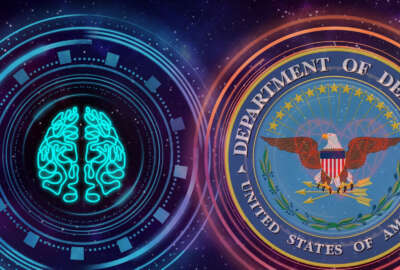

Lt. Gen. Bruce Crawford, the Army’s chief information officer, said the service’s new artificial intelligence task force will focus on tasks ranging from...
Not only is it joining in on the Defense Department’s Joint AI Center (JAIC), the Army is taking the understanding and use of AI and machine learning one step further.
Lt. Gen. Bruce Crawford, the Army’s chief information officer, said the service launched a new organization in September focused on bringing AI closer to the soldier and battlefield, and the business operations.
“The Army stood up an AI task force. The lead for that is Brig. Gen. Matt Easley, a signal officer. He reports directly to Army Futures Command,” Crawford said in an interview on Ask the CIO. “Let’s take a step back and think about the importance of AI. Two nation states in the last six months have made some declarative statements about the importance of AI. One nation state has said in an open forum that said the nation state that dominates in AI has the potential to rule the world. The other nation state has specifically said that AI is the key to overcoming the U.S. military as the most dominant fighting force in the world. If you think about the importance of AI, there is significant investment being made by peer competitors in the AI space.”

Crawford said his office’s role in supporting the AI task force is focused across six areas. These include the cloud infrastructure to ensure data is accessible and protected at all times.
To that end, the Army will update its data strategy and continue to implement its enterprise data analytics strategy.
Another big task is around developing and recommending policy changes around identity credentialing and access management (ICAM) to address data access challenges.
Crawford said improving the ICAM process becomes more important for two main reasons: data access and the increased reliance on the National Guard and reserve components.
“If you look at our guard and reserve, the vast majority of them do not have a government issued device, and likely don’t want one because they have their personal device. So why shouldn’t we pursue an option that allows us to containerize government information on their personal device?” he said. “That allows them to use their personal device to access the things they need and reside on the government networks. What I’m talking about is a two-factor authentication solution. There is a cloud piece of this. There is a data piece of this. But there really is a readiness piece of this because today that’s a capability gap for our guard and reserve.”
He said the two-factor authentication approach could include a biometric or another factor, but it all comes back to ensuring the data is accessible anytime and from anywhere.
A third task is improving the certification and accreditation process based on the risk management framework.
Crawford said the transition to the risk management framework has been more difficult for the military services than initially thought.
“What it came with was about an 800 percent increase in workload, the number of things you have to do. It didn’t come with any money or resources to do that,” he said. “As you can imagine when we transitioned from the Defense Information Assurance Certification and Accreditation Process (DIACAP) to RMF, there was a dip in our stats in terms of certification and accreditation and a backlog was created in terms of authorities to operate. What’s the one thing that prevents something from receiving an ATO on your network, whether it’s cloud and data or weapons system? It’s the risk management framework. It has to be streamlined.”
The Army is working with partners across DoD and the intelligence community to create a more streamlined and automated risk management framework process.
Crawford said his office is developing criteria that AI software can quickly check and cyber workers can give the system an interim authority to operate on the network while the rest controls are implemented.
“It is one of the fundamental things that we have to do in order to achieve the vision of the Army 2028. We’ve got to figure out how to streamline the RMF process so that we can get the speed that is required to be able to get things connected to the network and get weapons systems and technology to the solider,” he said.
Crawford said the AI task force is part of how his office is evolving its focus for 2019 and beyond around the enterprise.
“There are three categories of things we have to focus on. First and foremost, back to readiness because we anchor ourselves back into readiness, there are things we have to fix. A lot of our legacy infrastructure are at or nearing end of life whether you are talking about the actual transport capability or the voice telephone capability. There are things we have to fix,” he said. “There are things we have to optimize. We spent the first 12-to-18 months networking the solider and networking the weapons systems. What we haven’t done is optimize the enterprise to fully enable that networked solider and that networked weapons system. Finally, next generation technologies in terms of actual modernization. If you think about the capability that 5G brings, our current infrastructure is not set to in order to properly leverage 5G.”
Copyright © 2024 Federal News Network. All rights reserved. This website is not intended for users located within the European Economic Area.
Jason Miller is executive editor of Federal News Network and directs news coverage on the people, policy and programs of the federal government.
Follow @jmillerWFED


